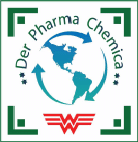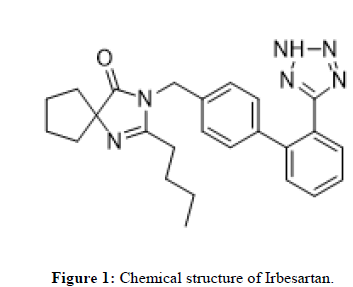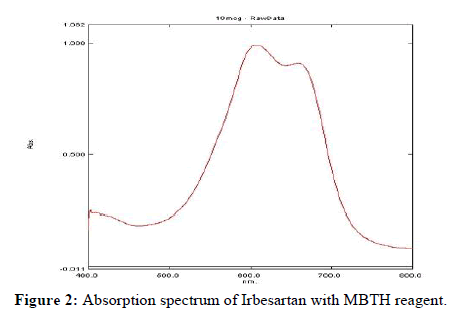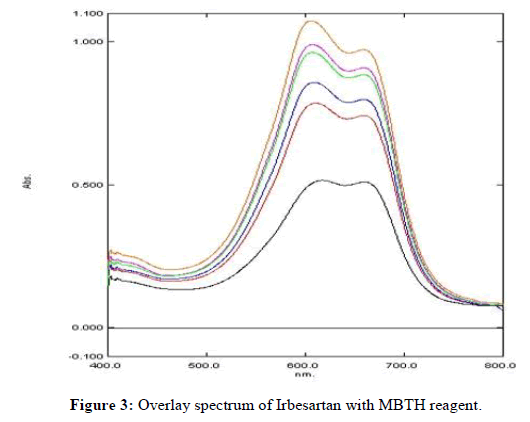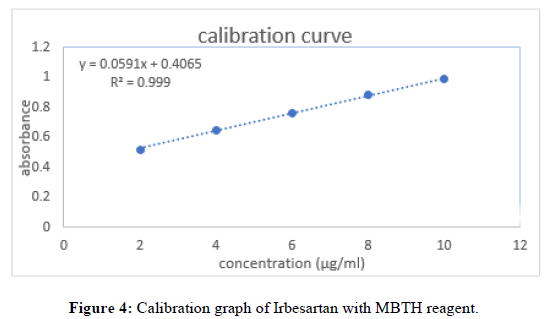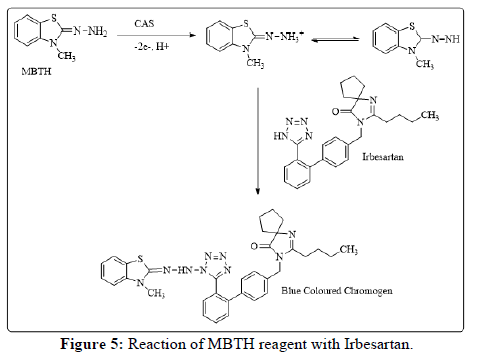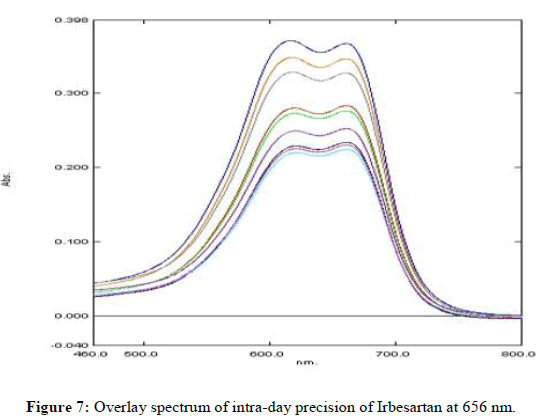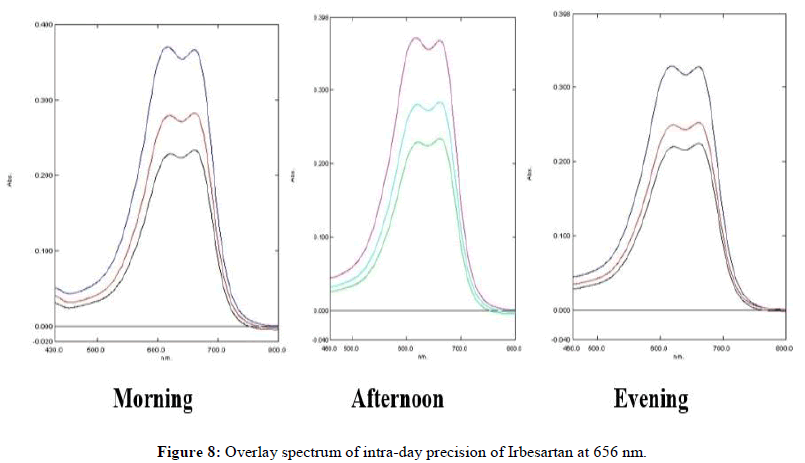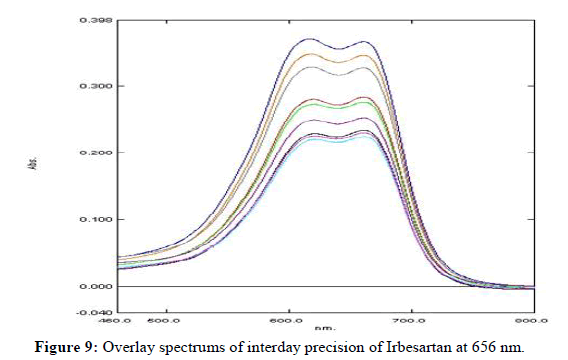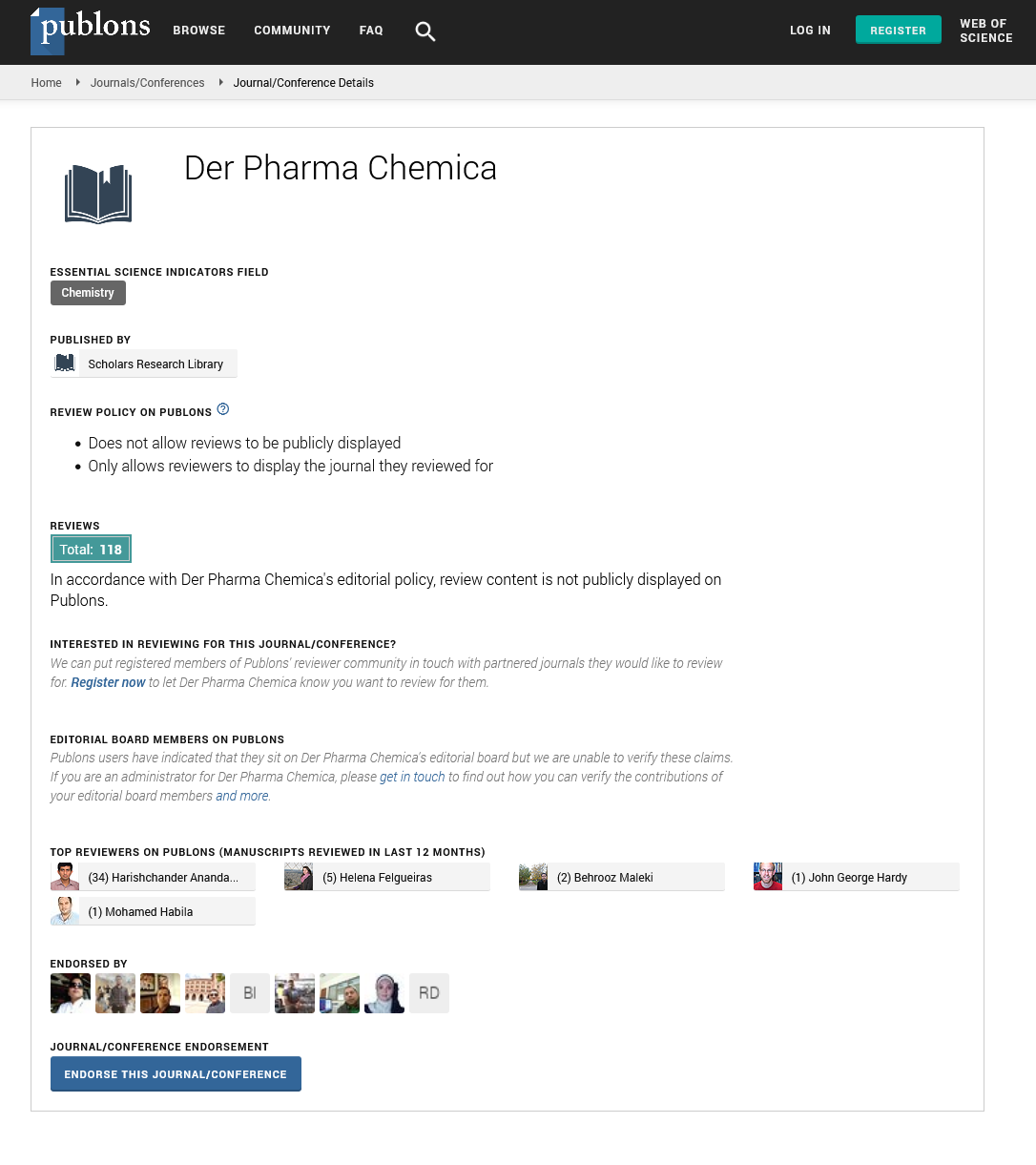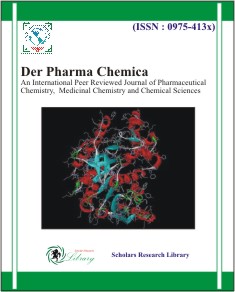Research Article - Der Pharma Chemica ( 2024) Volume 16, Issue 6
Quantitative Analysis of Irbesartan in Pharmaceutical Formulation Using MBTH Reagent
Gousia Tazeen, K. Manju Sri, P. Lekhana, Y. Padmavathi and N. Raghavendra Babu*N. Raghavendra Babu, Department of Pharmacy, G. Pulla Reddy College of Pharmacy, Mehdipatnam, Hyderabad, Telangana, India, Email: nayakaraghavendrababu@gmail.com
Received: 20-Nov-2024, Manuscript No. DPC-24-152952; Editor assigned: 23-Nov-2024, Pre QC No. DPC-24-152952 (PQ); Reviewed: 07-Dec-2024, QC No. DPC-24-152952; Revised: 01-Dec-2024, Manuscript No. DPC-24-152952 (R); Published: 29-Dec-2024, DOI: 10.4172/0975-413X.16.6.535-542
Abstract
A novel, simple, sensitive and efficient method has been established for the quantification of Irbesartan in bulk and pharmaceutical formulations utilizing the MBTH reagent. The objective of this analytical validation approach is to substantiate its efficacy by laboratory trials, demonstrating that the method satisfies the requisite minimal requirements for laboratory application. 3-methyl-2-benzothiazoline hydrazone interacts with the secondary amine group of Irbesartan in the presence of the oxidizing agent cerric ammonium sulphate. The resultant blue chromogen, when analysed spectrophotometrically in the visible spectrum (400 nm-800 nm), exhibits a peak absorbance at 656 nm. This approach can be effectively utilized for quantifying drug content in pharmaceutical formulations. The analysis results have been statistically confirmed. A coefficient of determination (r²) of 0.999 indicated adherence to Beer-Lambert's law across the concentration range of 2 to10 μg/mL. The limit of quantification and limit of detection limits were determined to be 1.2 μg/mL and 0.39 μg/mL, respectively.
Keywords
Irbesartan; Spectrophotometrically; MBTH reagent; Validation
Introduction
Irbesartan is utilised either individually or in together with other medications to manage hypertension. It was also utilized to manage renal illness resulting from diabetes in individuals with type 2 diabetes (a disorder characterized by the body's improper use of insulin, leading to an inability to regulate blood sugar levels) and hypertension [1]. Irbesartan belongs to the class of pharmaceuticals known as angiotensin II receptor antagonists. It functions by inhibiting the effects of specific natural substances that constrict blood arteries, facilitating smoother blood flow and enhancing the heart's pumping efficiency [2]. Irbesartan with chemical name of 2-Butyl-3-[[4-[2-(2H-tetrazol-5-yl)phenyl]phenyl]methyl]-1,3-diazaspiro [4] non-1-en-4-one having molecular formula of C25H28N6O with molecular weight of 428.5 gm (Figure 1) [3].
Literature survey identifies many methodologies for the quantitative analysis of Irbesartan. The techniques employed for the study of Irbesartan comprise high-performance liquid chromatography [4,5] mass spectrometry and liquid chromatography-mass spectrometry [6,7]. The quantification of biological fluids typically necessitates trace analytical methodologies, including HPLC, LC, Capillary Electrophoresis (CE), cyclic voltammetry, LC-MS, Gas Chromatography-Mass Spectrometry (GC-MS) and inductively coupled plasma-mass spectrometry [8]. These methods necessitate extensive and laborious pre-treatment of the materials, along with rigorous cleanup processes before analysis. No official monograph for Irbesartan is present in any pharmacopoeia and the determination of Irbesartan in bulk and pharmaceutical formulations has yet to be reported. A literature review has indicated that there are only a limited number of spectrophotometric methods for the measurement of Irbesartan in bulk drugs and pharmaceutical formulations. There exists significant potential for the development of a straightforward and appropriate analytical spectrophotometric approach for the quantification of Irbesartan in bulk and pharmaceutical formulations [9,10]. UV-Visible spectrophotometry is the preferred technique in research laboratories, hospitals and pharmaceutical businesses because of its affordability and natural simplicity.
MBTH has been utilized as a chromogenic reagent for the spectrophotometric quantification of various therapeutic amines. Nevertheless, the interaction between MBTH and Irbesartan has yet to be examined. This work evaluates MBTH as a chromogenic reagent for developing a simple and rapid spectrophotometric method to determine Irbesartan in pharmaceutical dosage forms.
Materials and Methods
Equipment
The UV-Visible spectrophotometer (Shimadzu-1800), interfaced with a computer equipped with Shimadzu UV Probe 2.0 software, has been utilised for every spectrophotometric measurement. The Shimadzu BL-220H electronic balance was utilized for sample weighing. The PCI Analytics 6.5-liter 2000H Ultrasonic bath sonicator is utilized for sonication purposes.
Reagents and solutions
All the reagents and chemicals used are of analytical grade and procured from SD fine chemicals Pvt Ltd, Mumbai. Irbesartan was obtained as gift sample from Aizant drug research solutions Pvt. Ltd, Hyderabad. Irovel 300 mg was obtained from the local pharmacy.
Preparation of 0.2% MBTH
20 mg of MBTH was introduced in 10 mL of purified distilled water.
Preparation of 1% w/v ceric ammonium sulphate
Dissolve 1g of ceric ammonium sulphate in 20 mL of 0.1 N H2SO4. Sonicate and make up to the volume using 100 mL purified distilled water.
Preparation of stock solution
A 10 mL volumetric flask was filled with 10 mg of standard Irbesartan, which had been weighed and dissolved in ethanol. A concentration of 1000 μg/mL was obtained by shaking, sonicating and adjusting the flask with ethanol until the final volume was 10 mL. The concentration of 100 μg/mL was obtained by transferring 1 mL of this stock solution into a different 10 mL volumetric flask and adding distilled water to bring the volume up to 10 mL.
Analytical method development
A series of 10 mL volumetric flasks were filled with fresh aliquots of Irbesartan, ranging in size from 0.2 mL-1 mL, taken out of the stock solution (100 μg/mL), in order to attain final concentrations between 2 μg/mL and 10 μg/mL. Incorporate 1 mL of 0.2% MBTH into each flask and allow it to stand for 5 minutes. Subsequently, introduce 0.2 mL of 1% w/v ceric ammonium sulphate and allow a 10-minute incubation period for colour development, specifically a blue colour. Adjust the volume utilizing purified distilled water. A graph of absorbance vs. concentration was developed by measuring the obtained chromogen absorbance at 656 nm with respect to the reagent blank that corresponds, as shown in Figures 2-4 displays the regression equation and correlation coefficient.
Results and Discussion
This approach involves the reaction of the drug with MBTH in the presence of ceric ammonium sulphate, resulting in a blue-colored product. This is an oxidative coupling reaction of MBTH with the pharmaceutical compound. Under the specified reaction conditions, MBTH undergoes oxidation to produce an electrophilic intermediate, which serves as the active coupling species. The intermediate engages in electrophilic substitution with the Irbesartan to yield the coloured product. The interaction between the MBTH reagent and Irbesartan is depicted in Figure 5. Consistent results were achieved within the temperature range of 20°C-40°C. The reagent blank exhibits minimal absorbance within the detection range for Irbesartan. Beer’s rule is adhered to within the concentration range of 2 μg/ml-10 μg/ml for Irbesartan.
The optimisation of spectrophotometric conditions aimed to address the many objectives of technique development. Analytical conditions were refined by a series of exploratory tests. The ideal circumstances for the reaction were meticulously examined. Optimal absorption at 656 nm was achieved instantly with the use of 0.2 ml of 1% Ceric ammonium sulphate and 1 ml of 0.2% MBTH at room temperature, with the product maintaining stability for 45 minutes.
Stability of chromogen
The interaction between Irbesartan and MBTH concluded within 20 minutes. The produced blue colour was determined to be stable over an extended period, exhibiting no alteration in colour intensity over time. This enabled the approach to be applied for intra-day analyses.
Optimization of parameter
The ideal concentration and volume were determined based on their capacity to yield maximal absorbance. Various concentrations and volumes were tested for all chemicals by systematically altering one parameter at a time. The optimal concentration of MBTH reagent was determined to be 0.2% w/v, while the optimal concentration of ceric ammonium sulphate was discovered to be 1% w/v. The optimal volume was determined to be 1 mL for MBTH and 0.2 mL for ceric ammonium sulphate.
Quantification
The constraints of Beer’s law, the molar absorptivity and the Sandell’s sensitivity values were assessed and are presented in Table 1. Regression analysis of the Beer’s law plots at their corresponding λmax values demonstrated a strong association. Graphs depicting absorbance against concentration exhibited a zero intercept and are characterised by the regression equation, y=bx+c (where y represents the absorbance of a 1 cm layer, b denotes the slope, c indicates the intercept and x signifies the drug concentration in μg/ml) derived by the least-squares approach. The findings are encapsulated in Table 1.
| Parameters | Conditions |
|---|---|
| λmax (nm) | 656 nm |
| Beer’s law range (μg/mL) | 2-10 µg/mL |
| Limit of Detection (LOD) (µg/ml) | 0.39 µg/mL |
| Limit of Quantification (LOQ) (µg/ml) | 1.2 µg/mL |
| Regression equation(y) | y=0.0592x+0.4065 |
| Intercept | 0.4065 |
| Slope | 0.0592x |
| Correlation coefficient (r2) | 0.999 |
Note: Y=mx+c; c denotes the concentration of Irbesartan in microgram per millilitre, while ‘y’ signifies the absorbance determined at λmax.
Table 1: Optical characteristics and validation data of Irbesartan.
Analytical validation
Limit of detection and limit of quantification: LOQ and LOD has been calculated as given below:
LOD=3.3σ/S
=0.39 μg/ml
LOQ=10 σ/S
=1.2 μg/ml
The suggested method to analyze Irbesartan was shown to have sensitivity with Limits of Detection (LOD) of 0.39 and Limits of Quantification (LOQ) of 1.2 μg/ml.
Precision
Repeatability, intra-day and inter-day precision studies were conducted in order to evaluate the precision.
Repeatability
Repeatability results are derived from the preparation of six replicates of standard solutions containing Irbesartan. The results are presented in Table 2 and Figure 6.
| S. No | Concentration (µg/mL) | Absorbance | Mean ± standard deviation* | % RSD |
|---|---|---|---|---|
| 1 | 6 | 0.373 | 0.369 ± 0.003 | 0.8 |
| 2 | 6 | 0.368 | ||
| 3 | 6 | 0.365 | ||
| 4 | 6 | 0.37 | ||
| 5 | 6 | 0.366 | ||
| 6 | 6 | 0.371 |
Table 2. Repeatability data of Irbesartan using MBTH reagent.
The values of % RSD was obtained within the limits. Hence the method has found to be repeatable.
Intraday and interday precision
Three replicates of three distinct concentrations of Irbesartan are prepared utilising MBTH reagent to assess the intra-day and inter-day precision results. The outcomes are displayed in Table 3 and Figures 5-7.
| S. no | Concentration (µg/mL) | Intraday-absorbance mean ± standard* deviation | %RSD | Interday-absorbance mean ± standard deviation* | %RSD |
|---|---|---|---|---|---|
| 1 | 8 | 0.274 ± 0.004 | 1.49 | 0.271 ± 0.002 | 0.7 |
| 2 | 6 | 0.228 ± 0.003 | 1.54 | 0.225 ± 0.00305 | 1.3 |
| 3 | 10 | 0.331 ± 0.004 | 1.3 | 0.329 ± 0.002 | 0.6 |
Note: * Average of three replicates
Table 3: Intraday and Interday Precision data of Irbesartan with MBTH reagent.
The developed method demonstrates precision, as the %RSD values are within the acceptance criteria, specifically less than 2% (Figures 7-9).
Accuracy
The %RSD value for Irbesartan was calculated to evaluate the accuracy of the developed method; the results are shown in Table 4.
| S. no | Concentration (µg/mL) | Absorbance mean ± standard deviation* | % RSD |
|---|---|---|---|
| 1 | 4.8 | 0.529 ± 0.007 | 1.47 |
| 2 | 6 | 0.588 ± 0.01 | 1.77 |
| 3 | 7.9 | 0.633 ± 0.009 | 1.55 |
Note: *Average of six replicates.
Table 4: Accuracy results of Irbesartan using MBTH reagent.
The method developed demonstrates accuracy across three distinct levels (80%, 100% and 120%), with % RSD values consistently meeting the acceptance criteria of less than 2%. The accuracy was calculated and validated through recovery studies conducted at three distinct levels (80%, 100%, 120%). This involved mixing a known quantity of pure drug with the pharmaceutical dosage form, followed by the estimation of the percentage recovery. The results obtained are documented in Table 5.
| Tablet used | Amount of sample added (µg/ml)* | Amount of standard added (µg/ml)* | Total amount added (µg/ml) | Total amount recovered (µg/ml) | % Recovery |
|---|---|---|---|---|---|
| Irovel | 4.8 | 6 | 10.8 | 10.67 | 98.87 |
| 300 mg | 6 | 6 | 12 | 11.79 | 98.3 |
| 7.9 | 6 | 13.9 | 14.12 | 101.6 |
Note: *Average of six replicates
Table 5: Accuracy results of Irbesartan dosage form using MBTH reagent.
The results are within the specified range of 98.87%-101.6%, which falls within the acceptance limit of 98%-102%. The method which has been developed has obtained the results for % RSD and % recovery of drug product within the acceptable limits ensuring that the method is accurate.
Application of established spectrophotometric method for the determination of drug Irbesartan using MBTH reagent
The developed approach was subsequently utilised for the determination of Irbesartan in the commercially available formulations, specifically the tablet form Irovel 300 mg, produced by Sun Pharma, located in East Sikkim, India, which contains 300 mg of Irbesartan. The calculation of the percentage purity of the drug was performed. The results obtained are displayed in Table 6.
| Tablet used | Label claim (mg) | Amount found (mg)* | % Purity |
|---|---|---|---|
| Irovel-300 mg | 300 | 286 | 95 |
Note: *Average of six replicates
Table 6: Assay results of MBTH using MBTH reagent.
The findings were determined to fall within the acceptable range of 90%-110%.
Conclusion
The reagent employed in the suggested method are inexpensive, easily accessible and the procedures do not require any stringent reaction conditions or laborious sample preparation. Furthermore, the approach is devoid of interference from prevalent additives and excipients. The extensive application of the novel methodologies for routine quality control was clearly demonstrated by the assay of Irbesartan in both pure form and pharmaceutical formulations.
Acknowledgements
The authors thank the Aizant drug research solutions Pvt. Ltd, Hyderabad for providing the gift sample of Irbesartan and authors also thank principal, G. Pulla Reddy college of pharmacy for providing all the necessary facilities to complete the research work.
References
- Bramlage P, Durand-Zaleski I, Desai N, et al. Expert Opin Pharmacother. 2009; 10(11): p. 1817-1831.
[Crossref] [Google Scholar] [PubMed]
- Borghi C, Cicero AF. High Blood Press Cardiovasc Prev. 2012; 19: p. 19-31.
[Crossref] [Google Scholar] [PubMed]
- Darwish IA, Darwish HW, Bakheit AH, et al. Profiles Drug Subst Excip. 2021; 46: p. 185-272.
[Crossref] [Google Scholar] [PubMed]
- Mondal S, Pal A, Mondal P, et al. Int J Pharm Investig. 2020; 10(1).
- Tiwari HK, Monif T, Verma PR, et al. Asian J Pharm Res. 2013; 8(6): p. 346-355.
- Katteboina MY, Pilli NR, Inamadugu JK, et al. Int J Pharm Sci. 2015; 7: 335-340.
- Liu J, Xie B, Mai B, et al. J Anal Sci Technol. 2021; 12: p. 1-8.
- Biyani R, Yadav KS. J Appl Spectrosc. 2019; 86: p. 934-941.
- Pradhan KK, Panigrahi G, Sahu KC. Hypertension. 2010; 1(2): p. 3-4.
- Rahman N, Siddiqui MR, Azmi SN. Chem Pharm Bull. 2006; 54(5): p. 626-631.
[Crossref] [Google Scholar] [PubMed]
